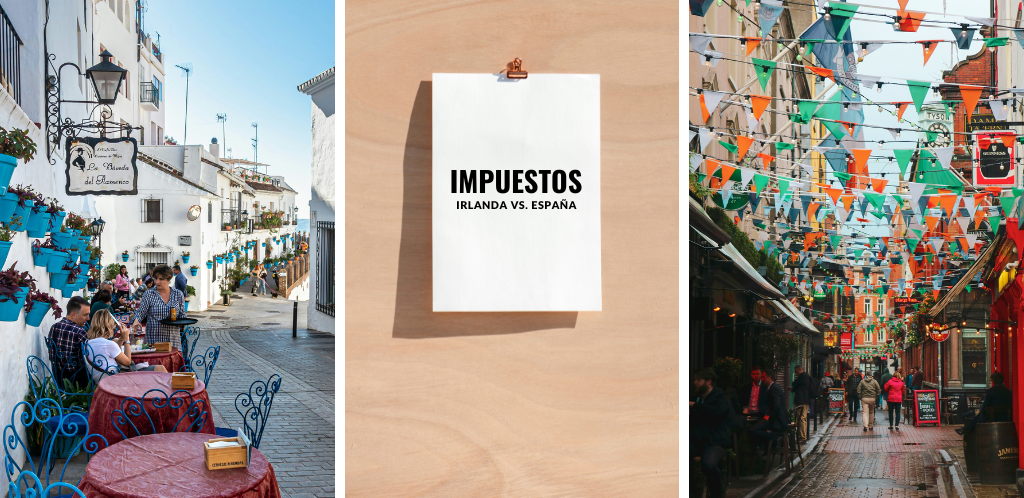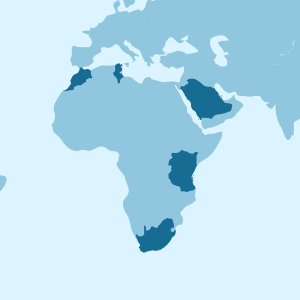Taxes in Ireland vs Spain: Which should I pay?
We compare the tax systems of Ireland vs. Spain. Want to find out which country would result in lower taxes for you?
Taxation in Ireland? If you have been researching the best countries for tax savings, you may have heard that many companies choose to establish themselves in Ireland to benefit from a more favourable tax regime. But how true is this? Would you pay less tax here than in other neighbouring countries? To verify what’s true, today we want to compare Ireland’s tax system with another European country. We’ll look at the taxes in Ireland vs Spain, with updated data for 2025.
Understanding the tax systems of both countries will help you optimise your finances, whether you’re an individual or a business owner. The taxes in both European countries differ not only in their rates but also in their application depending on the type of taxpayer and the size of the business. Choosing one country over the other could have a direct impact on your savings and profitability. If you’re considering relocating or investing, keep reading to discover which destination fits your plans best.

Taxes for businesses or legal entities
To start, if you’re interested in comparing the tax systems of Ireland vs Spain because you’re thinking of starting a business, you should know both countries have tax systems aimed at attracting investment. However, the structure and tax rates differ notably. This affects operating costs and profitability. Let’s look at the main taxes that affect companies in both countries, as well as the tax benefits available for emerging projects and SMEs.

Corporate Tax in Ireland vs Spain
This is one of the most important taxes to consider when deciding on a company’s location, regardless of size or sector. It taxes business profits and plays a key role in the overall tax burden faced by any company. Ireland and Spain present notable differences in their rates and structures.
- Ireland: Ireland has one of the most competitive corporate tax rates in Europe at 12.5%. This rate has made Ireland a magnet for large multinational corporations, particularly in the tech and finance sectors. However, income from real estate investment and other non-commercial activities is taxed at a higher rate of 25%. Moreover, Ireland has started implementing a 15% tax rate for large multinational corporations under OECD guidelines, aiming to balance its tax appeal with international standards.
- Spain: Spain, on the other hand, applies a general corporate tax rate of 25%, but new businesses benefit from a reduced 15% rate during their first two years of profit. Additionally, Spain offers significant deductions for activities related to research, development, and technological innovation (R&D&I) to encourage technological companies and startups to establish themselves in the country.
As you can see, while Ireland offers a lower general tax rate, Spain may be more favourable for new businesses and innovative projects, thanks to its R&D&I deductions and reduced rate for the first years of operation. The choice between both countries will depend on the type of activity you are carrying out and whether your business would benefit more from a low fixed rate or incentives for early-stage growth.
Business Activity Tax in Ireland vs Spain
Another important tax for businesses is the business activity tax, known in Spain as IAE. It taxes commercial and professional activities based on the type of activity and location. While the system differs in Ireland, there are certain taxes with similar functions. Spain:
- In Spain, the IAE applies to all companies with annual revenue exceeding one million euros. The rate varies based on the type of activity and the company’s location, with higher rates in urban areas. For example, businesses in sectors such as retail or industry may face higher rates in large cities, increasing their tax burden based on their activity.
- Ireland: Ireland does not have a local tax similar to the IAE that specifically taxes business activities. This means that companies do not have to pay an additional tax to operate in certain cities or regions, a significant advantage for those seeking to reduce local costs and establish themselves in urban areas without extra charges.
In short, in Spain, you will need to consider this tax when choosing your business location and budgeting. In Ireland, as this local tax does not apply, you’ll have the advantage of establishing your business wherever you wish.
Important: If you are a frequent traveler and want to stay connected without worrying about expensive roaming or looking for a new SIM at every destination, Holafly’s subscription plans are for you. With a single eSIM, enjoy internet in more than 160 countries for a fixed price and no surprises on your bill. Travel without limits and connect easily and securely! 🚀🌍

Property Tax (IBI or Commercial Rates) in Ireland vs Spain
This tax is relevant if your business owns property or if you plan to invest in real estate, as it represents a recurring cost. It is based on the cadastral value of each property. Both Ireland and Spain apply this tax, although the system and rates differ between the two countries.
- Ireland: In Ireland, the property tax is called Commercial Rates and is managed by the municipalities. The rates vary depending on the location and value of the property. Municipalities may offer exemptions or reductions to encourage business activity in specific areas. This local rates system provides some flexibility for businesses, especially in rural areas where rates tend to be lower.
- Spain: In Spain, the property tax (IBI) also varies depending on the municipality, with rates typically ranging from 0.4% to 1.3% of the cadastral value of the property. Each local council sets its rate, meaning that in urban areas, this tax can be significantly higher. As in Ireland, certain areas offer specific discounts, but the burden is generally less flexible.
Before setting up your business, you should bear in mind that Commercial Rates in Ireland tend to be lower and more flexible in rural areas. In contrast, IBI in Spain represents a higher tax burden in urban areas and lacks the same flexibility in exemptions.
VAT in Ireland vs Spain
VAT, or value-added tax, is an indirect consumption tax. The buyer bears the cost, although it is the businesses that manage it and include it in their prices. As you’ll see below, this tax functions similarly in both countries, but the general and reduced rates differ.
- Ireland: The general VAT rate in Ireland is 23%, one of the highest in Europe. In addition to this rate, reduced rates of 13.5% and 9% apply to specific goods and services, such as food and transport. Businesses must apply these rates to their sales and can deduct VAT from their purchases to reduce their net tax burden. Furthermore, intra-community transactions between registered businesses are exempt from VAT, facilitating trade within the European Union.
- Spain: In Spain, the general VAT rate is 21%. Reduced rates of 10% and 4% apply to basic products such as food, medicine, and some social services. As in Ireland, intra-community transactions between registered businesses are exempt from VAT, which promotes competitiveness in European trade.
In summary, the VAT rate in Spain is slightly lower than in Ireland. This structure helps ease the burden on everyday goods. If you’re engaging in transactions with other European businesses, both countries allow you to benefit from the VAT exemption.
Other Specific Taxes for Businesses in Ireland and Spain
In addition to the main taxes, both countries apply certain specific taxes that affect businesses based on their activity or type of investment. These taxes apply in specific circumstances and are important to understand, as they can represent an additional burden.
- Ireland: In Ireland, there is no specific national tax on activities or constructions. However, some sectors, such as mining or construction, may be subject to local taxes in areas of high economic activity or environmental protection. These taxes depend on local authorities and apply in limited circumstances.
- Spain: In Spain, the Construction, Installations and Works Tax (ICIO) applies to any construction or installation requiring a building permit. The rate can be as high as 4% of the actual cost of the project, which can represent a significant cost for construction companies or those needing to create new facilities.
In this regard, Ireland is more flexible as it does not have a general tax for specific activities, while Spain’s ICIO represents an additional burden for construction projects. This makes Ireland more favourable for businesses that require their own infrastructure in sectors like construction and industry.
Taxes for individuals or natural persons
Now let’s look at what happens regarding taxes in Spain and Ireland for individuals. Just like for starting a business, this is a key factor in deciding where to settle, as it impacts net income and savings capacity. Both countries apply progressive income taxes, although the structure and rates differ. Let’s review the main taxes affecting individuals in each country.

VAT in Ireland vs Spain
As we mentioned in the business section, VAT is an indirect tax applied to most goods and services. It directly affects the cost of living as it is the final consumer who bears this burden in their daily purchases. You will pay it whenever you buy something. Although both countries apply a similar VAT structure, the rates and certain specific criteria vary.
- Ireland: In Ireland, the general VAT rate is 23%, one of the highest in Europe. In addition to this rate, reduced rates of 13.5% and 9% apply to essential goods and services such as food and transport. This system allows for some reduction on essential products, although the percentage remains much higher than in Spain.
- Spain: In Spain, the general VAT rate is 21%, slightly lower than Ireland’s, while reduced rates are 10% and 4% for basic products such as food, medicines, and social services.
As mentioned above, the general VAT rate in Spain is lower, which could significantly reduce the price of goods and services.
Ireland vs Spain, Where is Personal Income Tax Lower?
Income tax is one of the most important taxes affecting individuals and a key factor when choosing a country of residence. In both countries, income tax is progressive. This means that the rates increase with the level of income. But let’s look at the differences in structure and rates:
- Ireland: Income tax has two main brackets: 20% for income up to €44,000 ($48,000) and 40% for income above this threshold (for individual taxpayers). While the higher rate is steep, the two-bracket system offers predictability for those earning above the initial threshold. Ireland also offers a range of personal tax credits that effectively reduce the tax burden, which is beneficial for residents with middle-range income.
- Spain: The Spanish personal income tax (IRPF) is more complex. The range of rates goes from 19% to 47%, depending on income level. Additionally, each autonomous community can adjust the final rate, introducing some variation. Despite the higher top rate in Spain, there are specific deductions and exemptions that relieve the tax burden, particularly for families and individuals with special needs, such as dependants or disability.
In conclusion, although Ireland offers a simplified two-bracket system, Spain’s progressive system allows more flexibility in deductions, especially for taxpayers with specific personal circumstances. Those seeking a lower tax burden on middle-range income may find Ireland a more straightforward and predictable option, while in Spain, personalised deductions can make a difference for certain profiles.
Wealth Tax in Ireland vs Spain
Wealth tax is a charge that affects individuals with significant assets or wealth. Spain applies this tax based on net wealth, while Ireland offers a more flexible environment in this regard.
- Ireland: Currently, there is no direct wealth tax in Ireland. This means that individuals with high-value assets, such as property, investments, or savings, are not required to pay a specific tax on these assets, which is especially attractive for those looking to minimise their long-term tax burden. However, it is worth mentioning that there are specific taxes on property and certain assets, which may still affect the budget.
- Spain: In Spain, the wealth tax applies to individuals whose net wealth exceeds €700,000 ($763,000), with an exemption of up to €300,000 ($327,000) for the primary residence. The rate is progressive, ranging from 0.2% to 3.5%, depending on the total value of the assets and the region. Additionally, some regions offer reductions or further exemptions for specific taxpayers.
The absence of a wealth tax in Ireland makes it an attractive option for those looking to preserve their assets long-term without paying additional taxes on their value. In Spain, this tax can be a significant cost for those with substantial assets, although regional exemptions can provide relief for certain profiles of taxpayers.
Inheritance and Donation Tax in Ireland vs Spain
Inheritance and donation tax is key in estate planning and transferring assets. This tax shows significant differences in its application in both countries, which could be crucial when choosing where to reside or establish family assets.
- Ireland: The inheritance and donation tax applies to beneficiaries of an inheritance or gift, with rates ranging from 33% to 40%, depending on the relationship and value of the received assets. There are three categories of beneficiaries, with close relatives such as children and spouses enjoying a higher exemption limit compared to other relatives or friends. Additionally, Ireland allows certain exemptions and reductions on inheritance tax for specific circumstances, such as when the beneficiary already resides in the inherited property.
- Spain: In Spain, the inheritance and donation tax depends on various factors, including the relationship, the region, and the value of the inheritance or gift. Rates vary significantly, from 7.65% to 34%, with each region having its own exemptions and reductions. For example, in some autonomous communities, direct heirs such as children and spouses can enjoy significant exemptions that reduce the impact of the tax, while in others, the burden can be higher, especially for distant relatives or non-relatives.
In general, the inheritance tax structure in Ireland allows higher exemptions for close relatives, although the final rates are higher compared to Spain. In Spain, the variability between regions offers both advantages and disadvantages, making tax planning a key factor when deciding where to reside or transfer assets.
Tax Comparison: Ireland vs Spain
Having looked at the most relevant taxes in both countries, which one is more suitable for you: Ireland or Spain? While both countries share some common taxes, each offers different structures and advantages. Ireland stands out for its low corporate tax rate. Spain offers advantages through deductions for innovative companies and initial reductions for startups. To help you decide which destination fits your profile, whether you’re an individual or business owner, let’s review a final comparison.

Taxes in Ireland vs Spain for Individuals
For individuals, both Ireland and Spain apply taxes on consumption, income, and wealth, though with significant differences. Ireland does not apply a specific wealth tax, which is advantageous for those with high-value assets, while Spain has regional exemptions that may reduce this burden in some cases. The following table shows the most relevant taxes for individuals in both countries:
| Tax | Ireland | Spain |
|---|---|---|
| VAT | 23% (standard); 13.5%, 9% (reduced) | 21% (standard); 10%, 4% (reduced) |
| Income Tax | 20% up to €44,000 ($48,000); 40% over €44,000 ($48,000) | 19% – 47% (progressive and regional) |
| Tax on heritage | Not available | 0.2% – 3.5% (over €700,000 ($763,000), with regional exemptions). |
| Inheritance and Gift Tax | 33% – 40%, depending on relationship and asset value | 7.65% – 34%, depending on relationship and autonomous community |
Tax comparison table Ireland vs Spain for individuals
In general, Spain offers a lower VAT burden and more deductions and exemptions on income tax. On the other hand, Ireland is an attractive option for those looking to reduce their tax burden on wealth and inheritance, as it does not apply a wealth tax.
Taxes in Ireland vs Spain for Legal Entities or Businesses
For businesses, Ireland and Spain present significant differences, especially in corporate tax and specific taxes applied to certain activities. In Ireland, the general corporate tax rate is one of the lowest in Europe, attracting large corporations. In Spain, however, new businesses can benefit from a reduced rate. Additionally, there are incentives for R&D&I activities, which is especially advantageous for startups and tech businesses.
| Tax | Ireland | Spain |
|---|---|---|
| Corporate income tax | 12.5% (standard); 25% for non-commercial income | 25% general; 15% for new businesses in the first two years |
| Business Activity Tax (IAE) | Not available | Applies to companies with turnover over €1,000,000 ($1,090,000); varies by activity and municipality. |
| Property Tax (IBI / Commercial Rates) | Varies by municipality | 0.4% – 1.3%, depending on municipality |
| VAT | 23% (standard); 13.5%, 9% (reduced) | 21% (standard); 10%, 4% (reduced) |
| Construction, Installations, and Works Tax (ICIO) | Not available | Up to 4% of the actual cost of the project |
Tax comparison table Ireland vs Spain for businesses
In conclusion, Ireland offers a lighter tax structure for companies looking to optimise their tax burden on profits and property, especially in sectors that do not require new constructions. On the other hand, Spain provides deductions and reduced rates for new businesses and innovative sectors, making it an attractive option for those wanting to take advantage of specific incentives in their early years of operation.
In conclusion, if tax burden is a key factor in your decision between Ireland vs. Spain when settling, you should consider both your tax profile and the objectives of your residency or business. If you find the whole tax topic complex, we recommend consulting with a specialist advisor to guide you in finding the country that best suits your circumstances. And don’t forget to check out the Holafly’s mensual plans for any questions you may have!














































 Pay
Pay  Language
Language  Currency
Currency 


















 No results found
No results found









